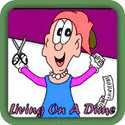
Although my children are older now, I wish I would have had this resource available when they were just learning to read. Rime to Read is a virtual program for beginning readers, and it reminds me a little of the Bob Books. However, what I REALLY like about these books is that the characters look like real little kids! My son just couldn't get over the fact that the Bob books had characters with triangle and other shaped heads!LOL
When my children, particularly my son, was beginning to learn to read, it would have been very beneficial to have little books like Rime to Read for him to read so that he could feel like he was accomplishing something. His greatest desire was to actually read a book, but it took a long time before he knew enough sounds to even read a simple reader. So I really feel these little learning booklets would be a great resource for your little ones just beginning to learn their sounds. And you can actually use these books to teach your children to read! The books are organized by rimes (words that look and sound alike, i.e. hat, sat, mat, pat, etc.) and you can purchase all 20 of them or just a vowel set f 4 books. Their prices are very reasonable ($44.99 for all 20, or $9.99 for a vowel set of 4 books) and you can try the first book for free at their website to see if this is something that can help you teach your child to read.
Here is what their site says about the program:
- Rime to Read is a beginning reading program comprised of 20 short books.
- The program is carefully structured to ensure success for the youngest readers as well as students needing remedial work.
- Each of the twenty books, four per short vowel, highlights a specific rime or word family (e.g., bat, cat, rat). Each rime is color-coded throughout the series with a different color.
- The color-coding of each rime encourages students to use visual similarities and differences to decode,a strategy employed by successful readers.
- The color-coding also helps students develop phonological awareness by providing cues for sound discrimination and categorization.
- Thirty-five common sight words are introduced and previewed the first five times they appear. Sight words are distinguished by black type.
So if you have little beginning readers in your family, take a moment to check out this great resource that will help those early readers feel a sense of accomplishment when they can read a whole book!






No comments:
Post a Comment